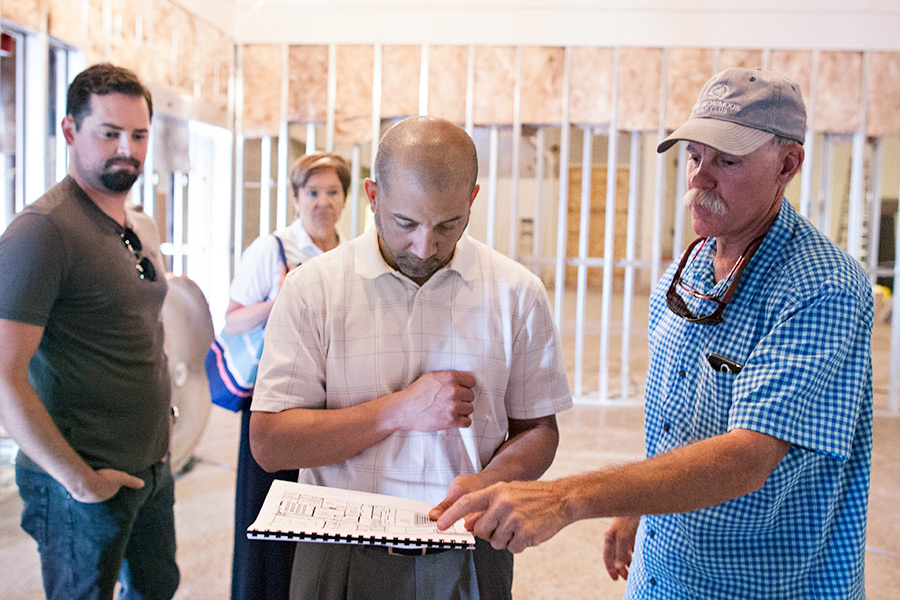WHITEFISH – Students who have ever wondered how an artistic verve evolves into a career, or what application a certain creative talent or technological savvy might have in the “real world,” will discover some clarity at Whitefish High School’s new cutting-edge performing arts and technology facilities.
Called the Center for Applied Media, Arts and Sciences, or CAMAS, the new $2.89 million facility stands poised to become a state-of-the-art hub of theater, music and technology studies at the revamped Whitefish High School.
Shawn Watts, a Whitefish School District trustee, said the acronym CAMAS is significant because it is also a robust and vibrant wildflower native to Montana.
The thrust of the CAMAS philosophy is to integrate “right brain” and “left brain” disciplines in an expanded, comprehensive curriculum, empowering students to compete in an interconnected and global landscape.
Whitefish School District Superintendent Kate Orozco said the innovative curriculum works in tandem with the high school’s new infrastructure, which was made possible when voters approved a $14 million bond request in 2012.
Although the district originally budgeted $558,000 to remodel existing music classrooms, they added $2.3 million to fully fund the CAMAS and complete the construction project by November.
Orozco said CAMAS, and the high school building project as a whole, aligns with a paradigm shift in education, positioning the school district at the vanguard of a movement to employ arts and technology as cores of curriculum, rather than ancillary components.
“In our day, we would go sit in a computer room to engage technology. That’s going away. Technology is ubiquitous now, both in our curriculum and outside of our curriculum,” Orozco said. “One of the biggest paradigm shifts for me was that we are raising these digital natives and they don’t speak our language.”
Even the CAMAS website at whitefishschools.com bears the high-tech flash of Silicon Valley, concealing the fact that it was actually collaborative effort between a high school student and a local graphic designer, Pete Thomas, the design director for TheZaneRay Group.
The collaborative design effort only serves to underscore the multi-discipline philosophy of CAMAS.
The student, Bergen Carloss, a junior, worked alongside Thomas to create a logo and website for the center. The logo features five multi-colored overlapping petals and is simple and elegant, like Apple’s iconic logo.
Carloss has also been working with local professionals to produce a series of short videos, called 60/60. The idea is for a CAMAS student to spend 60 minutes with a working professional in the community, and then produce a 60-second topical video that serves as a synopsis of the discussion.
Recently, Carloss spent a morning with Nick Spear, a local actor, songwriter, musician and vocalist. Asked by Carloss whether quality art can speak for itself, or if an artist should promote him or herself, Spear compared success as an artist to buying a parking permit – “just because you have the pass doesn’t mean you’re going to get a space.”
“How do they get that space?” Carloss asked.
“Networking, getting out there, shaking hands, sharing your art with people and letting them know you do what you do and that you are proud of it,” Spear explained. “If your ship doesn’t sail, swim out to it.”
Other installments have featured student Barrett Grey and Ruthann Lentz, a makeup artist on television show “Grimm,” and student Daniel Cameron talking the technology of city planning proposals with Whitefish city planner Dave Taylor.
“The goal is to align students with a specific interest in their professional counterparts,” according to Brett Allen, a supporter of the CAMAS project who has been producing the episodes. “Our current 60/60 episodes serve as vehicles to learn more about what is possible when students, parents, teachers, administration, and professionals collaborate. Our mantra is to do and learn, and change course to create a better end result.”
Dow Powell, the district’s construction representative, said the physical space shares many corollaries with the curriculum, which wouldn’t be possible without the state-of-the-art improvements.
“There are so many complements between the physical space and the philosophy,” Powell said.
To that end, Watts said the donations of philanthropists have been critical.
“That’s the vision. That’s the goal. To connect the community to the school and the school to the community, but we have to know that we’ll have a facility that is worthy of that partnership,” he said.
Without the donations, the project would not have been possible, but $800,000 remains to be raised. A fundraiser event is planned at 5:30 p.m., Aug. 18, at First Interstate Bank, 306 Spokane Ave., Whitefish. Whitefish High School music students will provide entertainment.
Donations can also be mailed to Whitefish Community Foundation, P.O. Box 1060, Whitefish, MT 59937 at the attention of “Whitefish High School Performing Arts and Technology Wing.”
With millions made available through donations for the center and the completed Jim Campbell Fitness Center, the construction project has increased in cost from an initial $19 million price tag to approximately $23 million.
